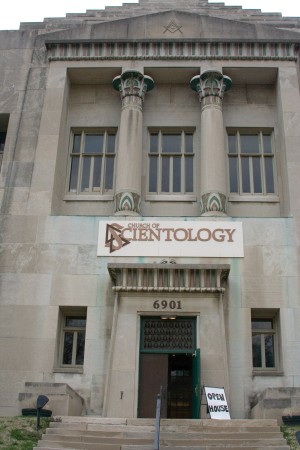Scene
Student Life investigates: The St. Louis Church of Scientology
The Scientology church nearest to campus is located at 6901 Delmar Boulevard. Casual visitors can receive literature and information from church staff.
Scientology’s relatively young roots lie in the writings and charisma of author L. Ron Hubbard. Though he died in 1986, the religion continues to grow steadily. I visited the Church of Scientology to discover what I could about the religion. I am convinced, however, that Scientology is not the most viable of options for students at Washington University.
Scientology’s various depictions in the media overwhelm most people’s knowledge of the actual religion. Tom Cruise, possibly the organization’s most infamous member, ceaselessly promotes Scientology and its teachings, and other portrayals have been negative: An episode of “South Park” describes Scientologists as believers in an ancient alien emperor, Xenu, whose genocide of billions of aliens caused the current world’s evil.
The representatives with whom I spoke prefer to present the Church as a self-help group, whose methods rest in rigorous and revolutionary science.
As I began my tour of the church, I first noticed both a large portrait of Hubbard hanging behind the receptionist’s desk and dozens of copies of Hubbard’s “Dianetics” on display. The receptionist was intently perusing a dictionary. I asked for introductory material, and one Scientologist, Mindy, whisked me away for an introduction to the religion. In a larger room, dominated by two likenesses of Hubbard, Mindy presented me with a personality test of 200 questions. Called the Oxford Capacity Analysis (OCA), the test asked for responses of “yes,” “no” or “maybe” to questions like “Are you a slow eater?” and “Does emotional music have quite an effect on you?” While bubbling in answers, I gazed around the room and noticed that more dictionaries rested on shelves. After completing all of the questions, I doubted the test could reveal much. I watched an abbreviated biography of Hubbard’s life while Mindy scored my test.
To my surprise, the results indicated that I was “badly withdrawn,” “inhibited and submissive” and “depressed.” According to Scientology, my life is, among other things, “an environment of chaos and trouble.” The OCA measures 10 aspects of personality and assigns each a numerical value. I didn’t understand the graph of my results, mostly because there were no units on the vertical axis. To help me understand the invisible units, Mindy personally reviewed my results with me. When discussing particularly low scores, she asked what parts of my life would contribute to such results. I didn’t answer, possibly due to my “inability to communicate freely,” or perhaps because I don’t share personal matters with people I met only 20 minutes ago. Mindy advised purchasing Scientology courses as a remedy.
Scientology, in Hubbard’s own words, is “the science of knowing how to know answers.” Ideally, at least according to Mindy, the courses would improve my life as a whole and lead to greater knowledge.
My visit had raised more questions than it answered, as some contradictions arose through minimal skepticism and research. The short biography about Hubbard claims that he “embarked on another investigatory trail” thanks to his college class about nuclear physics. Yet, according to Michael Streeter’s “Behind Closed Doors,” a book about Scientology and other secret societies available through Google Books, Hubbard flunked the sole course he took in molecular and atomic physics. When I asked about this and other discrepancies between Scientology’s account and other records, Mindy shrugged. She likened the inconsistency to the controversy surrounding other historical figures, such as Jesus.
Examination of the OCA highlights other problems. I asked Tim Bono, a psychology graduate student, how psychologists evaluate personality tests. He replied that they first consider the validity and reliability of a test; a valid test has been shown to measure what it claims to measure, and a reliable test produces similar results each time. An investigation by a group of psychologists, concluded that the OCA was invalid. Most trials of a valid test, when answered randomly, should yield results close to the mean. When the Working Party answered the OCA randomly, however, their results, like mine, were far from the mean. I obtained a copy of the OCA and a scoring guide, replicated the investigation, and arrived at similar results. Even the name “Oxford Capacity Analysis” is misleading. I asked Mindy for the reason behind the name. She said that Hubbard wrote the exam in collaboration with Oxford University. I have found no source independent of the Church of Scientology that supports this claim.
Another beef I had with the religion proved the most thought provoking. Scientologists believe that psychiatric drugs like Prozac and Ritalin damage the brain and even deny the existence of the conditions these drugs are used to treat. Mindy adamantly insisted that the science behind modern psychiatry was inherently flawed and a danger to patients. The effectiveness of such drugs, she repeated, has “never been proven.” I am not a neuroscientist, and my confidence in these drugs stems from confidence in the scientific method. The difference between Mindy and me is a disagreement in faith. My belief lies with empirical science, while Scientology adheres to Hubbard’s writing.
As banal as some of Scientology’s views may seem, I still respect their right to their own beliefs. A society that can accept Creationism has room for Xenu as well. It turns out that they advocate looking up words in the dictionary to overcome barriers to study. Scientology’s methods do not lead to truth or necessarily to progress, but it remains their right. Still, the OCA and the Church’s staunch rejection of psychiatry are enough to keep me away from Scientology.

